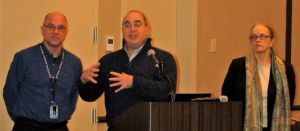

Three National Science Foundation (NSF) program directors are encouraging ATE principal investigators to become involved in The Future of Work at the Human-Technology Frontier (FW-HTF) and Harnessing the Data Revolution—two of NSF’s Ten New Big Ideas for Future Investment—because they have the potential to overlap with technician education.
At the first convening of the Preparing Technicians for the Future of Work (PTFOW) project on December 13 in Washington, D.C., Jordan Berg, a program director in the Division of Civil, Mechanical & Manufacturing Innovation (ENG/CMMI), said NSF program directors would “very, very much like to see people who have their sleeves rolled up and their arms plunged in to education playing major roles in the intellectual merit and research component of these proposals.”
Berg and two other program directors—Robert Scheidt and Stephanie August—presented information about these funding opportunities to the 26 ATE center principal investigators who the PTFOW project had gathered as an ATE Leadership Caucus to help inform its work over the next four years. The project led by Principal Investigator Ann-Claire Anderson, vice president of special projects at the Center for Occupational Research and Development (CORD), seeks to enable the ATE community to collaborate regionally and across disciplines with industry partners to transform associate degree programs to prepare US technicians for the future of work.
The project’s 10 industry advisors also attended the meeting. At the meeting the ATE educators and industry advisors identified the following technologies as drivers of transformative workplace changes: artificial intelligence, the internet-of-things, cybersecurity procedures, advanced robotics, digital design, and prototyping. See http://preparingtechnicians.org for more information about the ATE Leadership Caucus meeting and the project’s podcasts, regional convenings, and workshops.
Scheidt, a program director in the Division of Civil, Mechanical & Manufacturing Innovation (ENG/CMMI), provided details about The Future of Work at the Human-Technology Frontier (FW-HTF) as an opportunity for ATE principal investigators to work with developers and researchers to examine the impact of technological innovations on technicians.
NSF is seeking a third round of proposals for FW-HTF (Solicitation 19-541) for projects that encourage innovators to anticipate the technological, cognitive, social, and economic impact of new technologies while they are developing products. To improve understanding of the relationships between technology and people, projects must have a mix of disciplines and can be led by educators at any postsecondary level. Proposals for research grants ($1.5 to $3 million for up to four years) and planning grants to build teams ($150,000 for one year) are due March 6, 2019.
August, a program director in the Division of Undergraduate Education who is also on the FW-HTF working group, said attending the 2018 ATE Principal Investigators’ Conference added to her awareness that the ATE community is doing cross-discipline work. She said, “It’s really exciting to see the two communities coming together and we would like to see more symbiosis there.”
She then gave two examples of ATE projects that are working at a high level with developers of emerging technologies:
- Learning Program for Cobots in Advanced Manufacturing Systems (#1601454) is teaching community college students to use cobots and secondary teachers to teach about robotics; and
- The Associate of Applied Science in Dynamic Reality Technologies Program: Training Technicians to Use Extended Reality to Develop Workforce Training Simulations (#1800942) that is using extended reality for workforce training simulations.
Scheidt shared information about four FW-HTF collaborative research projects “to give snapshots of where technologists, economists, and social scientists believe we are headed:”
- Pre-Skilling Workers, Understanding Labor Force Implications and Designing Future Factory Human-Robot Workflows Using a Physical Simulation Platform (#1839971) is designing future factory human-robot workflows using a physical simulation platform to understand labor force implications.
- Enhancing Human Capabilities through Virtual Personal Embodied Assistants in Self-Contained Eyeglasses-Based Augmented Reality (AR) Systems (#1840131) is developing an embodied Intelligent Cognitive Assistant (GLASS-X), an eyeglass-based 3-D mobile telepresence system with integrated virtual personal assistant to amplify the capabilities of workers.
- Whole-body Exoskeletons for Advanced Vocational Enhancement (WEAVE) (#1839946) is exploring industrial applications of powered exoskeletons.
- Augmented Cognition for Teaching: Transforming Teacher Work with Intelligent Cognitive Assistants (#1840120) is testing an artificial intelligence system that monitors students’ attention and provides real-time information to teachers.
August, who also works in the Harnessing the Data Revolution program, shared information about the Data Science Corps (Solicitation 19-518) that seeks proposals for building capacity for data science. The deadline for proposals is February 4. She suggests reading Data Science for Undergraduates, a National Academies of Science report published in 2018.

 Subscribe
Subscribe


 See More ATE Impacts
See More ATE Impacts

Comments
There are no comments yet for this entry. Please Log In to post one.